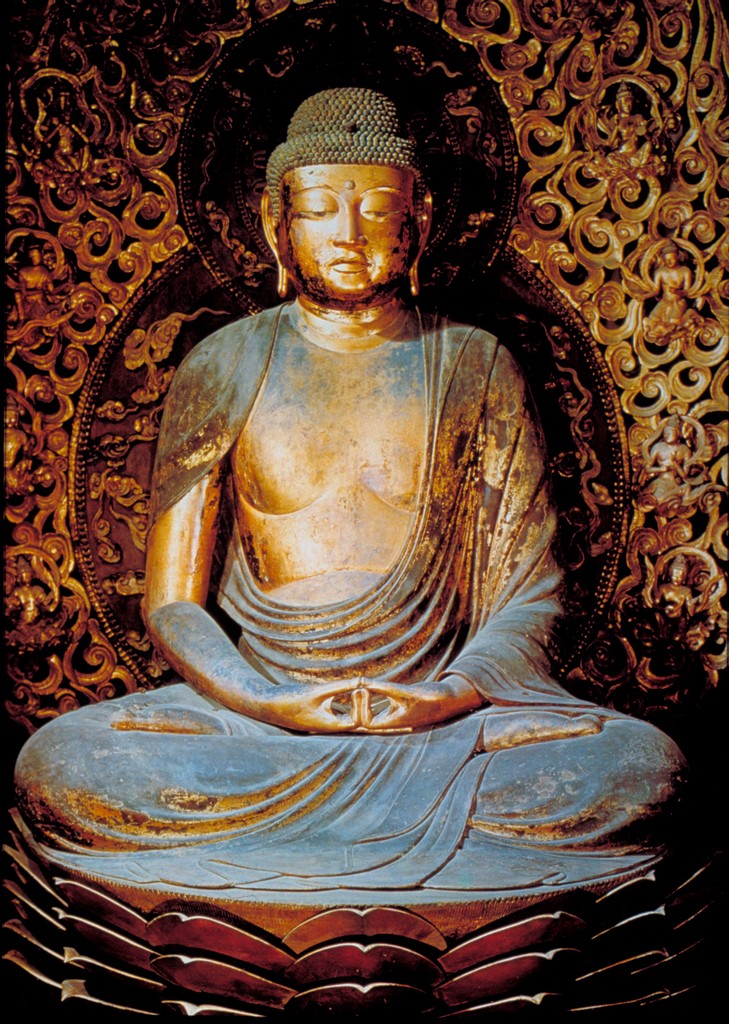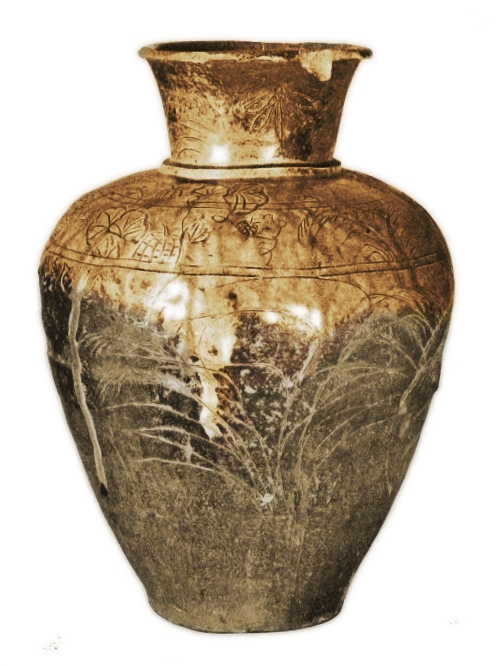Preceded by the Early Heian Period, the Late Heian Period occurred from 894-1186. The flourishing of art, architecture, literature, and spirituality characterizes the period. The Fujiwara family held control of the courts and sought to decentralize the state through Shōen Koryo Sei development. In doing so, the government relinquished control of the land system to provide the aristocracy with private ownership. Additionally, the Fujiwara family sought to control its lineage through diplomatic intermarriages. However, outside of Kyoto’s capital, peasants worked the land and were subjected to excessive taxation. As a result, rebellions occurred, leading to the transfer of power to the warrior class and marking the end of the Heian Period.
The Fujiwara family managed to transform Japanese society by promoting Buddhism. The transmission of Buddhist thought to Japan coexisted with Shinto, Japan’s indigenous system of venerating nature spirits and ancestors. Amidism was practiced under the notion that enlightenment was no longer attainable to humankind and that only the Buddha Amida could guarantee an escape from the cycle of death and rebirth. The late Heian monk Hōnen founded the Pure Land school, which promoted the practice of nembutsu. Nembutsu is a practice that encourages followers to recite the Buddha’s name in order to reach enlightenment. Thus, the Fujiwara’s interest in Amida Halls promoted rapid circumambulation around the Golden Buddha platform.

Date: 998-1053
Creator: Unknown
Collection: UMass Boston: Academic Images
Retrieved from: https://library.artstor.org/public/SS33119_33119_10271328
Source: http://commons.wikimedia.org/wiki/File:Byodoin_Phoenix_Hall_Uji_10-1R.jpg
The Phoenix Hall [Amida-dō] [Hōō-dō] was created as a country home for the Fujiwara clan but was converted to a temple by Yorimichi Fujiwara to enshrine the Buddha Amida. The construction sought to create a Land of Happiness through its design. The palace consists of the Chudo (the central Hall), left and right-wing corridors, and a tall corridor (the body and wings of the Phoenix). The layout contains a large pond which illuminates the construction of the Hall.The Jodo style inspired the garden as it sought to bring Pure Land into the living area.

Title: Amida Nyorai
Date: 1053
Location: Byodo-in, Phoenix Hall, Kyoto
Material: wood, covered with gold leaf
Creator: Jocho
Retrived from: https://library.artstor.org/#/asset/AHSC_ORPHANS_1071314157
Source: Data From: An Art Images for College Teaching
Jocho is referred to as the greatest Buddhist sculptor in Japanese history and employed the Yosegi-zukuri (wooden mosaic work) structure. The Amida Buddha in the Phoenix Hall has been declared the “True Figure of Buddha.” The Amida Buddha is situated on a lotus base and holds a wooden disc marked with a prayer (dharani) in black ink. Around the Buddha are fifty-two smaller sculptures depicting Bodhisattvas (enlightened beings) floating on clouds, dancing, and playing musical instruments. The back of the statue possesses a large gilt mandola, representing the union of opposites, such as heaven and earth.

Material: colors on paper
Date: 10th-12th C. A.D
Creator: Murasaki Shikibu
Retrieved from: https://library.artstor.org/#/asset/ARTSTOR_103_41822000412005
Source: Data from: University of California, San Diego
The style of painting utilized during the Late Heian Period is referred to as Yamato-e. The term Yamato-e means “Japanese painting.” The paintings are typically narrative stories meant to be read from right to left. Painters within the Early Heian Period were concerned with the image’s composition, thus emphasizing time and space within the scroll. Today, few Yamato-e paintings remain from the Heian period due to the execution of paintings on folding screens and sliding panels. They were intended to be used as functional architectural features but were lost due to the buildings being demolished. However, the existence of Yamato-e screens and panels is documented in prose and waka poetry.

Measurements: 183×154 cm
Date: late 9th century
Creator: Unknown
Material: hanging scroll, colors/silk
Location: To-ji, Kyoto
Retrieved from: https://library.artstor.org/#/asset/AHSC_ORPHANS_1071313562
Source: Data From: Art Images for College Teaching
Buddhists believe that they can attain Buddhahood during a single lifetime. Thus, practitioners meditate upon cosmic diagrams known as manuals in conjunction with hand gestures (mudras) and voicing sacred formulas (mantras). The Taizokai (Womb World) mandala comprises twelve zones representing different dimensions of Buddha nature. The center focus is the Vairocana Buddha within the lotus of compassion, surrounded by Buddhas and Bodhisattvas. The style reflects the Shingon sect, which believed all humans have an inherent Buddha nature. The colors are vivid, with rich red, blue, green, and gold shades.

??????????????????
Title: Autumn grass design
Location: Tokyo National Museum, Ueno, Taito, Tokyo, Japan
Date: Twelfth Century
Retrieved from: Kidder Textbook pg.174 https://archive.org/details/artofjapan0000kidd/mode/2up
The Production of ceramics suffered during the Late Heian period, which prompted artisans to find an alternative to celadon. This led to a renewed interest in stoneware and the practice of glazing, which had been neglected for two hundred or more years. Taking inspiration from the Chinese, Japanese artisans stamped floral patterns into their creations. This allowed artists to create their style and stray away from Chinese influences.
I was interested in researching the art and architecture of the Late Heian Period due to its rich history and culture. As a history minor, I enjoy learning about dynamic historical points contributing to societal growth. The Fujiwara family is unique in its attempts to redesign Japan’s government and way of life. The clan’s attempts to reproduce the concept of Pure Land on Earth were unique. Although many temples were destroyed when the city lost its administrative duties in 1189, they significantly influenced the subsequent construction of cities and temples in Japan. The concentration on the Buddha Amida was also interesting as it made me reflect on how different religions choose to be used in worship. I also enjoyed looking at the Yamato-e paintings and Mandalas prevalent throughout the period. Artists can present a narrative in many ways in a subjective manner. Expanding one’s imagination through narrative art is crucial to the progression of ethics and morality.
Japan-ness strives to encompass the social and historical context of the period. The Japanese aesthetic can be described as simple, humble, pure, and light. Japanese values of spirituality and culture are holistically embodied in art and architecture styles. Japan-ness is embodied through Japanese tradition and heritage. It is constantly evolving and seeks to move beyond the status quo. The examples I chose exemplify the values shared by Japanese society. A great deal of art and architecture during the Late Heian Period was used for religious purposes, hence, the incredible attention to detail. The pieces reflect a time of spiritual and cultural growth within the country as it sought to create its own style.
Works Cited:
Edward Kidder, The Art of Japan pgs. 139-174 (Century, 1985)
“13.3: The Heian Period.” Humanities LibreTexts, 1 May 2020,
https://human.libretexts.org/Bookshelves/Art/Art_History_(Boundless)/13%3A_Japan_
efore_1333_CE/13.03%3A_The_Heian_Period.
Byodoin. https://www.webpages.uidaho.edu/arch499/nonwest/japan3/byodoin.htm. Accessed 14
May 2023.
Fukuyama, Toshio. Heian Temples: Byodo-in and Chuson-Ji. 1st English ed, Weatherhill, 1976.
“Teaching about Heian Japan.” Association for Asian Studies,
https://www.asianstudies.org/publications/eaa/archives/teaching-about-heian-japan/.
Accessed 14 May 2023.
Willmann, Authors: Anna. “Yamato-e Painting | Essay | The Metropolitan Museum of Art |
Heilbrunn Timeline of Art History.” The Met’s Heilbrunn Timeline of Art History,https://www.metmuseum.org/toah/hd/yama/hd_yama.htm. Accessed 14 May 2023.